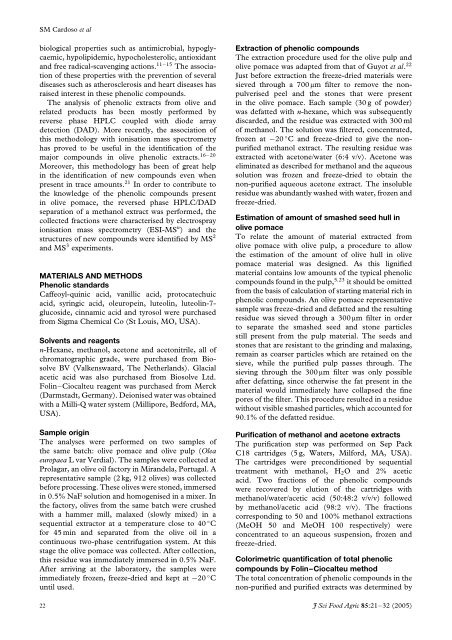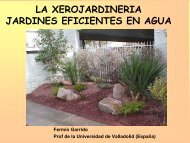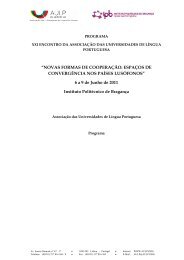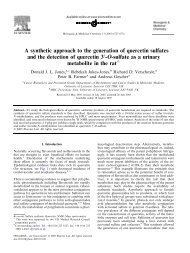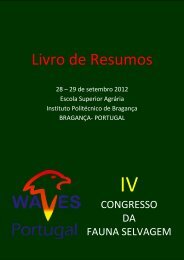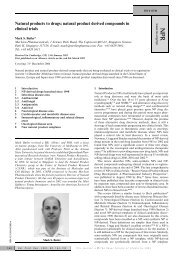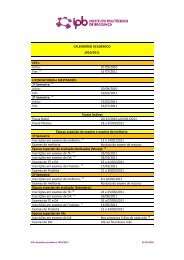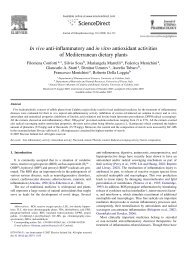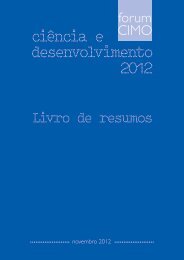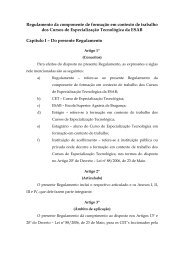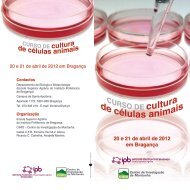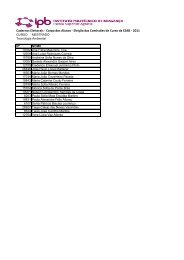Characterisation of phenolic extracts from olive pulp and ... - ESAC
Characterisation of phenolic extracts from olive pulp and ... - ESAC
Characterisation of phenolic extracts from olive pulp and ... - ESAC
Create successful ePaper yourself
Turn your PDF publications into a flip-book with our unique Google optimized e-Paper software.
SM Cardoso et al<br />
biological properties such as antimicrobial, hypoglycaemic,<br />
hypolipidemic, hypocholesterolic, antioxidant<br />
<strong>and</strong> free radical-scavenging actions. 11 – 15 The association<br />
<strong>of</strong> these properties with the prevention <strong>of</strong> several<br />
diseases such as atherosclerosis <strong>and</strong> heart diseases has<br />
raised interest in these <strong>phenolic</strong> compounds.<br />
The analysis <strong>of</strong> <strong>phenolic</strong> <strong>extracts</strong> <strong>from</strong> <strong>olive</strong> <strong>and</strong><br />
related products has been mostly performed by<br />
reverse phase HPLC coupled with diode array<br />
detection (DAD). More recently, the association <strong>of</strong><br />
this methodology with ionisation mass spectrometry<br />
has proved to be useful in the identification <strong>of</strong> the<br />
16 – 20<br />
major compounds in <strong>olive</strong> <strong>phenolic</strong> <strong>extracts</strong>.<br />
Moreover, this methodology has been <strong>of</strong> great help<br />
in the identification <strong>of</strong> new compounds even when<br />
present in trace amounts. 21 In order to contribute to<br />
the knowledge <strong>of</strong> the <strong>phenolic</strong> compounds present<br />
in <strong>olive</strong> pomace, the reversed phase HPLC/DAD<br />
separation <strong>of</strong> a methanol extract was performed, the<br />
collected fractions were characterised by electrospray<br />
ionisation mass spectrometry (ESI-MS n ) <strong>and</strong> the<br />
structures <strong>of</strong> new compounds were identified by MS 2<br />
<strong>and</strong> MS 3 experiments.<br />
MATERIALS AND METHODS<br />
Phenolic st<strong>and</strong>ards<br />
Caffeoyl-quinic acid, vanillic acid, protocatechuic<br />
acid, syringic acid, oleuropein, luteolin, luteolin-7-<br />
glucoside, cinnamic acid <strong>and</strong> tyrosol were purchased<br />
<strong>from</strong> Sigma Chemical Co (St Louis, MO, USA).<br />
Solvents <strong>and</strong> reagents<br />
n-Hexane, methanol, acetone <strong>and</strong> acetonitrile, all <strong>of</strong><br />
chromatographic grade, were purchased <strong>from</strong> Biosolve<br />
BV (Valkenswaard, The Netherl<strong>and</strong>s). Glacial<br />
acetic acid was also purchased <strong>from</strong> Biosolve Ltd.<br />
Folin–Ciocalteu reagent was purchased <strong>from</strong> Merck<br />
(Darmstadt, Germany). Deionised water was obtained<br />
with a Milli-Q water system (Millipore, Bedford, MA,<br />
USA).<br />
Sample origin<br />
The analyses were performed on two samples <strong>of</strong><br />
the same batch: <strong>olive</strong> pomace <strong>and</strong> <strong>olive</strong> <strong>pulp</strong> (Olea<br />
europaea L var Verdial). The samples were collected at<br />
Prolagar, an <strong>olive</strong> oil factory in Mir<strong>and</strong>ela, Portugal. A<br />
representative sample (2 kg, 912 <strong>olive</strong>s) was collected<br />
before processing. These <strong>olive</strong>s were stoned, immersed<br />
in 0.5% NaF solution <strong>and</strong> homogenised in a mixer. In<br />
the factory, <strong>olive</strong>s <strong>from</strong> the same batch were crushed<br />
with a hammer mill, malaxed (slowly mixed) in a<br />
sequential extractor at a temperature close to 40 ◦ C<br />
for 45 min <strong>and</strong> separated <strong>from</strong> the <strong>olive</strong> oil in a<br />
continuous two-phase centrifugation system. At this<br />
stage the <strong>olive</strong> pomace was collected. After collection,<br />
this residue was immediately immersed in 0.5% NaF.<br />
After arriving at the laboratory, the samples were<br />
immediately frozen, freeze-dried <strong>and</strong> kept at −20 ◦ C<br />
until used.<br />
Extraction <strong>of</strong> <strong>phenolic</strong> compounds<br />
The extraction procedure used for the <strong>olive</strong> <strong>pulp</strong> <strong>and</strong><br />
<strong>olive</strong> pomace was adapted <strong>from</strong> that <strong>of</strong> Guyot et al. 22<br />
Just before extraction the freeze-dried materials were<br />
sieved through a 700 µm filter to remove the nonpulverised<br />
peel <strong>and</strong> the stones that were present<br />
in the <strong>olive</strong> pomace. Each sample (30 g <strong>of</strong> powder)<br />
was defatted with n-hexane, which was subsequently<br />
discarded, <strong>and</strong> the residue was extracted with 300 ml<br />
<strong>of</strong> methanol. The solution was filtered, concentrated,<br />
frozen at −20 ◦ C <strong>and</strong> freeze-dried to give the nonpurified<br />
methanol extract. The resulting residue was<br />
extracted with acetone/water (6:4 v/v). Acetone was<br />
eliminated as described for methanol <strong>and</strong> the aqueous<br />
solution was frozen <strong>and</strong> freeze-dried to obtain the<br />
non-purified aqueous acetone extract. The insoluble<br />
residue was abundantly washed with water, frozen <strong>and</strong><br />
freeze-dried.<br />
Estimation <strong>of</strong> amount <strong>of</strong> smashed seed hull in<br />
<strong>olive</strong> pomace<br />
To relate the amount <strong>of</strong> material extracted <strong>from</strong><br />
<strong>olive</strong> pomace with <strong>olive</strong> <strong>pulp</strong>, a procedure to allow<br />
the estimation <strong>of</strong> the amount <strong>of</strong> <strong>olive</strong> hull in <strong>olive</strong><br />
pomace material was designed. As this lignified<br />
material contains low amounts <strong>of</strong> the typical <strong>phenolic</strong><br />
compounds found in the <strong>pulp</strong>, 5,23 it should be omitted<br />
<strong>from</strong> the basis <strong>of</strong> calculation <strong>of</strong> starting material rich in<br />
<strong>phenolic</strong> compounds. An <strong>olive</strong> pomace representative<br />
sample was freeze-dried <strong>and</strong> defatted <strong>and</strong> the resulting<br />
residue was sieved through a 300 µm filter in order<br />
to separate the smashed seed <strong>and</strong> stone particles<br />
still present <strong>from</strong> the <strong>pulp</strong> material. The seeds <strong>and</strong><br />
stones that are resistant to the grinding <strong>and</strong> malaxing,<br />
remain as coarser particles which are retained on the<br />
sieve, while the purified <strong>pulp</strong> passes through. The<br />
sieving through the 300 µm filter was only possible<br />
after defatting, since otherwise the fat present in the<br />
material would immediately have collapsed the fine<br />
pores <strong>of</strong> the filter. This procedure resulted in a residue<br />
without visible smashed particles, which accounted for<br />
90.1% <strong>of</strong> the defatted residue.<br />
Purification <strong>of</strong> methanol <strong>and</strong> acetone <strong>extracts</strong><br />
The purification step was performed on Sep Pack<br />
C18 cartridges (5 g, Waters, Milford, MA, USA).<br />
The cartridges were preconditioned by sequential<br />
treatment with methanol, H 2 O <strong>and</strong> 2% acetic<br />
acid. Two fractions <strong>of</strong> the <strong>phenolic</strong> compounds<br />
were recovered by elution <strong>of</strong> the cartridges with<br />
methanol/water/acetic acid (50:48:2 v/v/v) followed<br />
by methanol/acetic acid (98:2 v/v). The fractions<br />
corresponding to 50 <strong>and</strong> 100% methanol extractions<br />
(MeOH 50 <strong>and</strong> MeOH 100 respectively) were<br />
concentrated to an aqueous suspension, frozen <strong>and</strong><br />
freeze-dried.<br />
Colorimetric quantification <strong>of</strong> total <strong>phenolic</strong><br />
compounds by Folin–Ciocalteu method<br />
The total concentration <strong>of</strong> <strong>phenolic</strong> compounds in the<br />
non-purified <strong>and</strong> purified <strong>extracts</strong> was determined by<br />
22 J Sci Food Agric 85:21–32 (2005)


